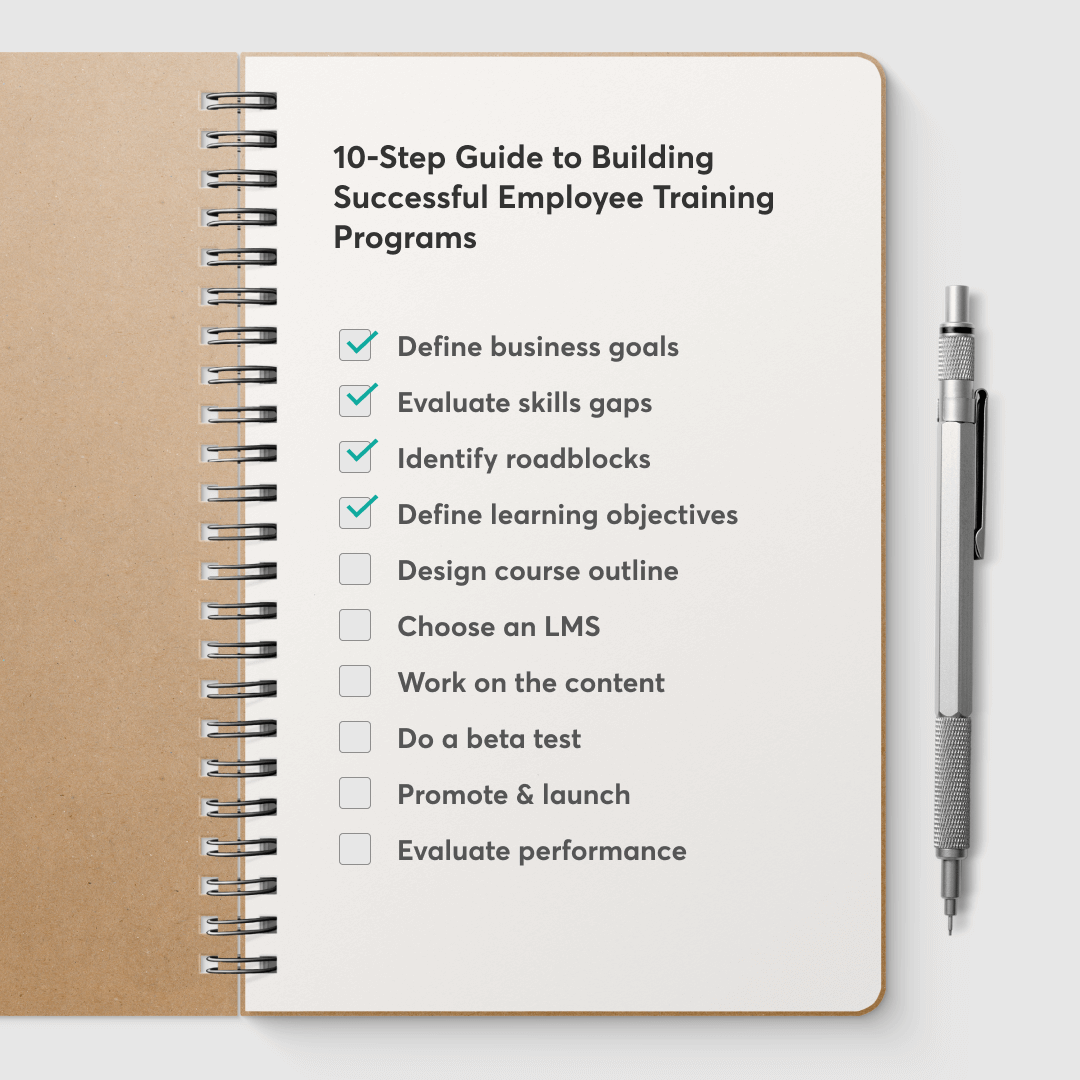Table of Contents
Employee training programs are one of the top benefits modern employers offer. In fact, 8 out of 10 employers provide formal education either to upskill their employees or to keep their skills fresh.
But there’s more to that. Sharp skills translate into better performance, more opportunities for career advancement, and, therefore, higher job satisfaction. And make no mistake – a competent workforce that is also happy plays a huge role in the success of your business.
While you may already be on board with the idea of investing in your employees’ professional development, you might be under the impression that you don’t have the budget, expertise, or human resources to create an effective training program.
Today, we’ll show you how all of these issues are solvable, and that you can indeed build employee development programs. (Hint: you probably already have more resources readily available than you think – we’ll talk about that, too).
All you really need to do is create and follow a structured training plan. Delivering training online, or at least complementing it with online resources, will also support your effort to make Learning and Development part of your workplace culture.
9000+ brands trust LearnWorlds to train their people, partners & customers.
Start a FREE TrialIn this post, we’ll go through this training plan together. But first, let us make our case for online training.
Why You Should Deploy Employee Training Online
First things first, we’re not in favor of an “either-or” approach. Online training is not always the solution. For instance, it can’t substitute hands-on practice for technical and manual tasks. Imagine training a construction worker how to operate a lift from the comfort of their home – would you like to be around when they try it in real life?
That said, online training fits the bill for technical and soft skills training programs. You can also support most types of on-site training with training material and activities, and create blended learning experiences.
Let’s see the benefits and use cases one by one 👉
Offer convenience and flexibility
Online courses are often self-paced or combine synchronous with asynchronous elements. The training material is available 24/7 and can be accessed from any device provided there’s an internet connection. Employees can set their own schedule for learning inside or outside work hours without interrupting their work day. No uncomfortable daylong seminars, no unnecessary commuting.
Provide just-in-time training
Deskless employees, like salespeople or healthcare professionals, don’t have the same access to on-the-job training as everyone else does. Online, and mobile learning in particular, is the only way to support these employees when they’re on the job.
Streamline and document training
A Learning Management System helps you streamline your training efforts by providing the same quality training to everyone. On top of that, it allowed you to create your own learning hub – a centralized location with all the learning resources your employees need.
Trim your training budget
Your primary training goal is to help employees build their skills in the most effective way possible, so cost-efficiency shouldn’t be a determining factor unless online training makes sense.
That said, when you deploy training online vs in-person, you will save big on expenses like instructor fees, venue, accommodation, and transportation costs – not to mention the time lost from productivity.
Cater to diverse learning styles & needs
Online learning leaves more room for variety, which is especially beneficial for visual learners who prefer to take their time walking through the content. By including a mix of written, audio, and kinesthetic activities, eLearning can provide comprehensive learning experiences for everyone.
Apart from preferences, employees also have different needs. Physical, learning, or cognitive disabilities might hinder some employees from keeping up or even participating in on-site training. Online courses are easier to work around and be accessible for everyone.
Easily update your content
Things move fast in the modern workplace. New products, new employees, new regulations, new skills, new information. With online training, it’s easy to keep your employees up to date without having to organize training events from scratch. All you need to do is upload updated training content on your training platform.
Cultivate a learning culture
Online training is much easier both for the company to deploy and update and for employees to follow through. This means you can roll out new and diverse courses regularly and keep the momentum going.
9000+ brands trust LearnWorlds to train their people, partners & customers.
Start a FREE TrialYour 10-Step Guide to Building Successful Employee Training Programs
Let’s move from theory and unshakeable arguments pro online training to the actual planning & development phase. We have created a concrete 10-step mini-guide for you to follow:

1. Define Your Business Goals
Defining your business goals is the first step to building a successful training program. You don’t need to go wild here and plan for the next decade. Focus on what you want to achieve in the foreseeable future so that you can set specific and measurable goals.
🎯 Many businesses use the SMART methodology to define their goals:
Let’s say you’re a SaaS company. A SMART goal sounds like this:
“Increase our CSAT score by 5% by the end of 2024.”
Based on this goal, ask yourself: Which new knowledge and skills does your workforce need to help you achieve the goals? This brings us to the next step.
2. Evaluate Skills Gaps & Training Needs
In many cases, the problem might not be your employees but your processes or business strategy – even the tech you’re using, or your product! Therefore, before designing a new training program, you must revisit and reevaluate all business operations linked to your goals.
At the same time, you need to conduct a training needs assessment. You have several options for this:
After you’ve received feedback from multiple sources, you should be able to figure out the skills gaps among your workforce and start planning your next training program to address these gaps.
3. Identify Potential Barriers
Next, you should consider the challenges you may face as you deploy training. Typically, these involve:
Keeping potential roadblocks in mind will help you design a program tailored to your needs, preferences, and capabilities and choose the training delivery method that best works for your company.
4. Define the Learning Objectives
Now, you have all the information that you need to start writing the learning objectives of the course. The learning objectives are a short but concise description of what employees will be able to do after they complete the training course.
Think of them are the Unique Selling Points of the course – the answer to the “What’s in it for me?” question. A quick tip is to avoid generic verbs like “learn or understand” and focus instead on action-oriented ones. Here’s what a learning objective sounds like:
By the end of this sales course, you’ll be able to:
Having defined the learning objectives, you can select the best activities that will bring learners closer to those and also the assessments that will effectively measure their knowledge.
5. Design a Course Outline
With a course outline, you’ll create a roadmap and organize your content into learning modules. A course outline will help you create the course sequence and define the much-necessary knowledge checkpoints and reward systems.
Designing a training course is not always simple because the learning process is not. If your requirements are complex, you might need to outsource content creation or hire an instructional designer.
If you don’t have an instructional design expert on your team, don’t hesitate to consult one. It’s best to spend some more money now and get the job done right than develop a program that misses the mark.
Visit the LearnWorlds Experts Directory to discover qualified eLearning professionals who can help you build your training course.
6. Choose an Employee Training Platform
According to a survey conducted by Training Magazine, Learning Management Systems remained the most popular learning technology used in 2023.
This comes as no surprise: an LMS helps you organize and distribute your training content with significantly fewer hassle and cost compared to other solutions. In addition to that, LMSs support diverse content types and enable you to create training that has an impact.
Depending on your specific needs and the type of training, your requirements may differ. For example, if you want to conduct live sessions, you should look for a platform that directly integrates with a video conferencing tool. If you need to train deskless employees, you need an LMS with a mobile app, and so on.
Even if you don’t know the exact features to look for, by describing your requirements to the LMS vendor, they should be able to demonstrate they can address those needs.
In the meantime, here are some important considerations for every company:
7. Start Working on the Content
If you decide to develop the training in house, we have two words of advice for you before you even get started:
The first is to identify team members with expertise in the course topic. Use them as your Subject Matter Experts to organize mentoring sessions or advise with course creation.
Second, use content you already have! Yes, even those dreaded PowerPoint presentations can be turned into something more exciting, like an eBook. A webinar can also be turned into a series of videos, and so on. Think about what you already have before you start building content from scratch.
In the meantime, some popular types of content to include in your course are:
Remember that every learning activity must be relevant to the training objectives and, whenever possible, reinforce real-life application. Avoid overloading your employees with nice-to-have information because this will hurt their capacity to absorb even necessary knowledge.
If necessary, add live instructor-led training sessions during which you can explore case studies and real-world examples, dive deeper into the topic, answer questions, and practice with role-playing exercises to improve knowledge retention. Leverage discussion boards and community features to enable employees to share knowledge and engage in discussions.
Want to know more about how to create personalized learning experiences? Watch our free webinar Personalize Your Corporate Training Experiences.
8. Do a Beta Test
Before launching your program, take one final look through the eyes of others. Create a small team of employees who will access the course while it’s still in draft mode, then conduct a group discussion to get their feedback.
9. Promote & Launch
Does an internal training program need to be promoted? Yes. You need to help employees see the value they can get from it. You need to make a commotion and let enthusiasm spread among your employees!
Therefore, a couple of weeks before you launch the course, send an email or post an announcement to let employees know that the course is ready. Share a sneak peek and highlight perks for course participants, like paid time off or a special reward for top performers. Most importantly, explain how the course is linked to career opportunities.
10. Measure How Effective The Program Was
Typically, a training program ends when employees have finished the course successfully. But the most important thing is the aftermath. A training program always leaves you with important questions to answer:
Answering these questions irequires a systematic approach: launch employee surveys and interviews, check your LMS reports, measure your KPIs, and discuss with managers.
It’s pretty much what you did before designing the program to evaluate your needs – only now you have more sources to collect data, and the focus is different. You also need to remember that business KPIs take a while to improve and that, usually, there’s more than one factor at play.
Ready to Launch?
Offering continuous education has multiple benefits for a company. Your employees are the building blocks of your business – and no business can go far unless it keeps its employees’ skills current and the employees themselves happy with their jobs.
LearnWorlds is an excellent choice for your employee training initiatives. Our platform is a lightweight LMS you can implement in a few hours and even launch your branded mobile app, supercharged with an advanced AI assistant with built-in prompts.
Scalable and flexible, LearnWorlds is fully white-labeled, SCORM compliant, offers multiple integrations and API, customer user roles and access controls, and poses no limits to the number of courses or users you can have.
We could go on for a while. Why don’t you leverage our 30-day free trial to discover the amazing capabilities of LearnWorlds?
9000+ brands trust LearnWorlds to train their people, partners & customers.
Start a FREE TrialFurther reading
- The 19 Best Learning Management Systems
- SCORM 101: The Definitive Guide to Choose a SCORM Compliant LMS
- How to Create a Course Outline [With Templates]
- The Essential Guide on How to Create Cohort-Based Courses
- 10 Best WordPress LMS Plugins Comparison
- What is an LMS (Learning Management System)?
- The Benefits of Mobile Learning: Unveiling Its Power and How It Works

Androniki Koumadoraki
Androniki is a Content Writer at LearnWorlds sharing Instructional Design and marketing tips. With solid experience in B2B writing and technical translation, she is passionate about learning and spreading knowledge. She is also an aspiring yogi, a book nerd, and a talented transponster.



